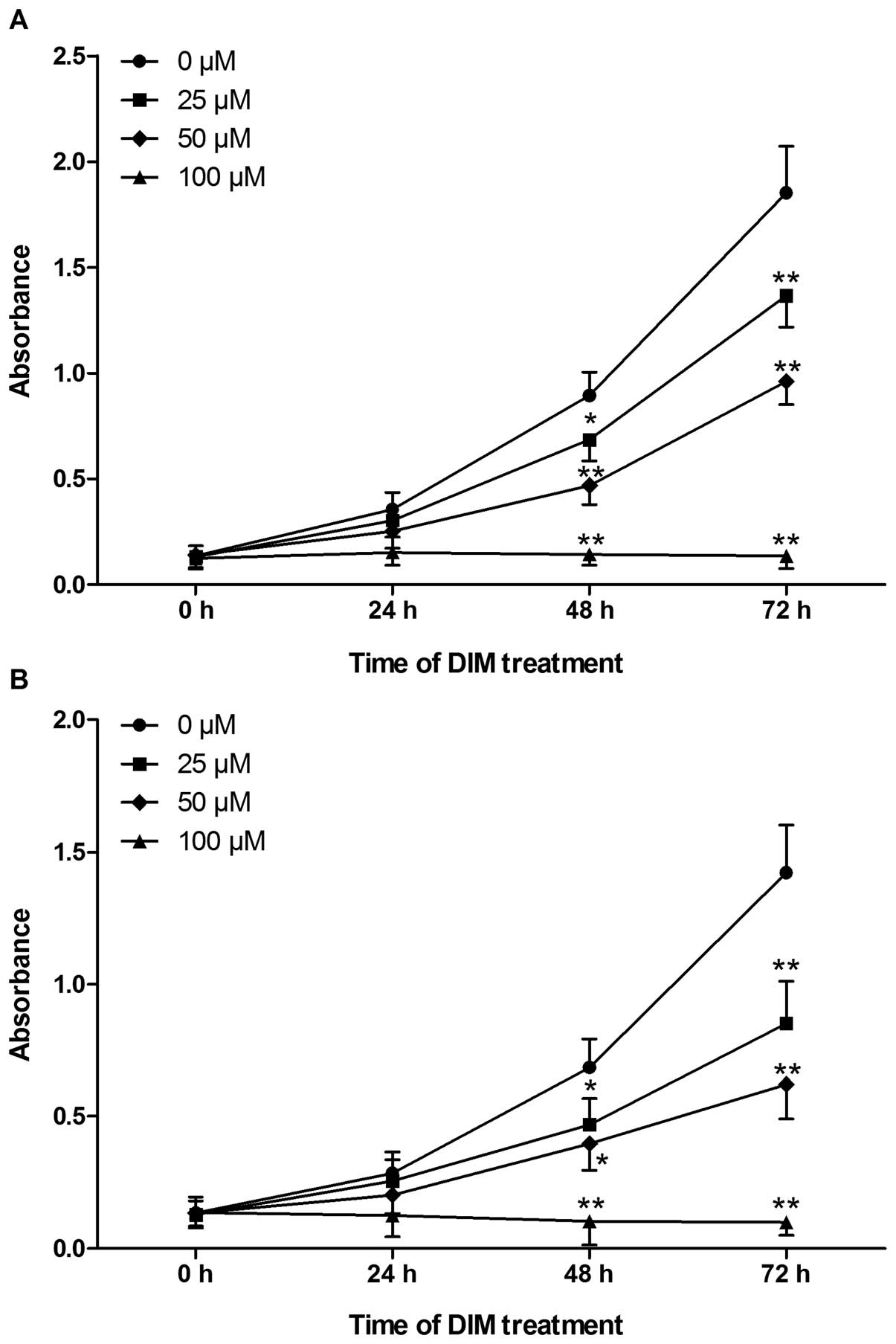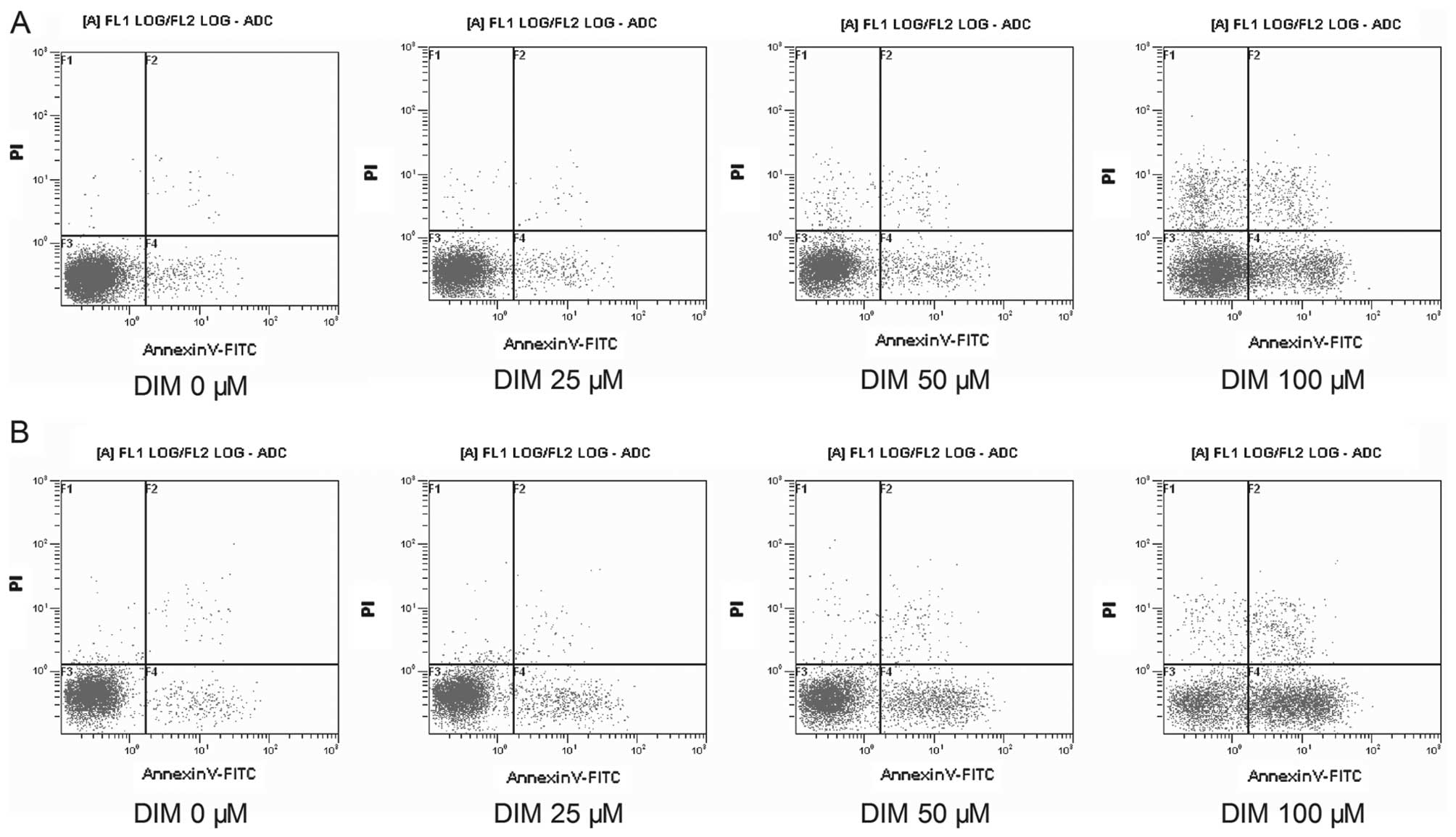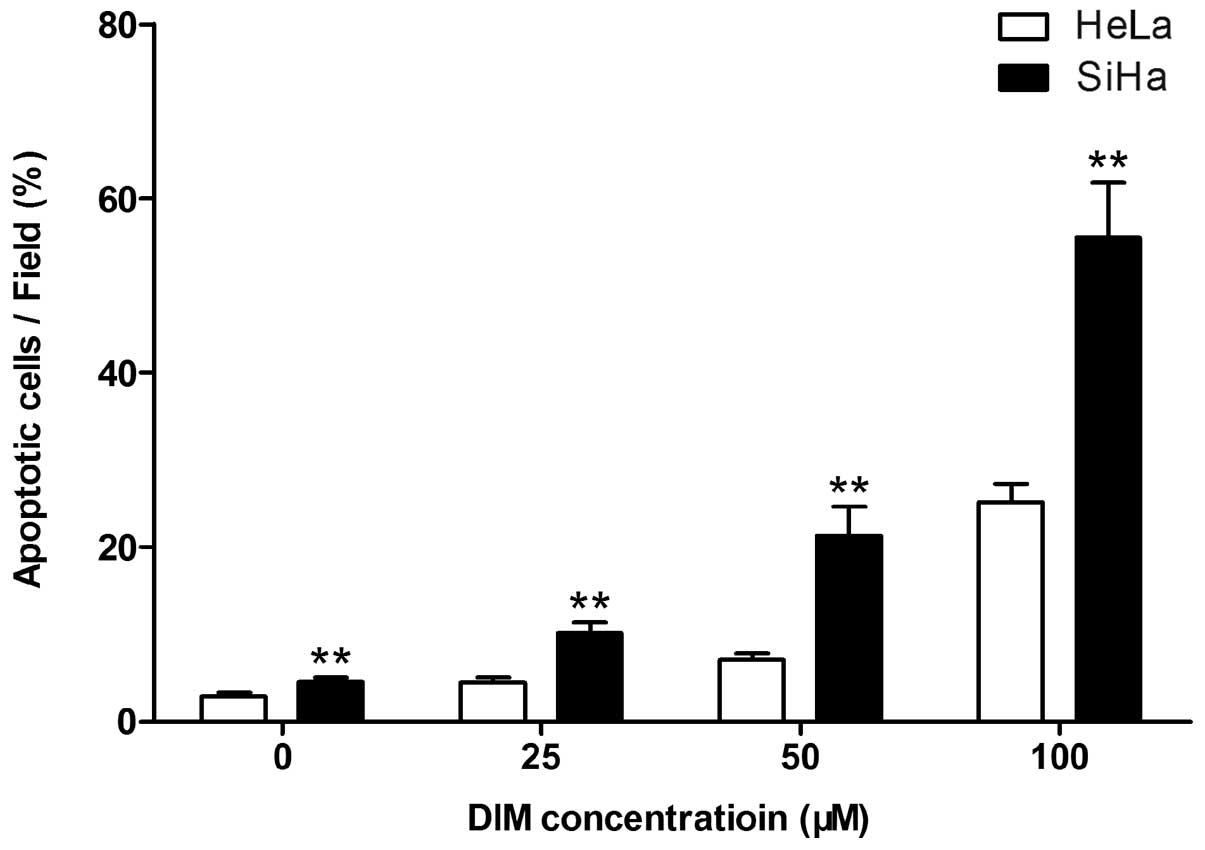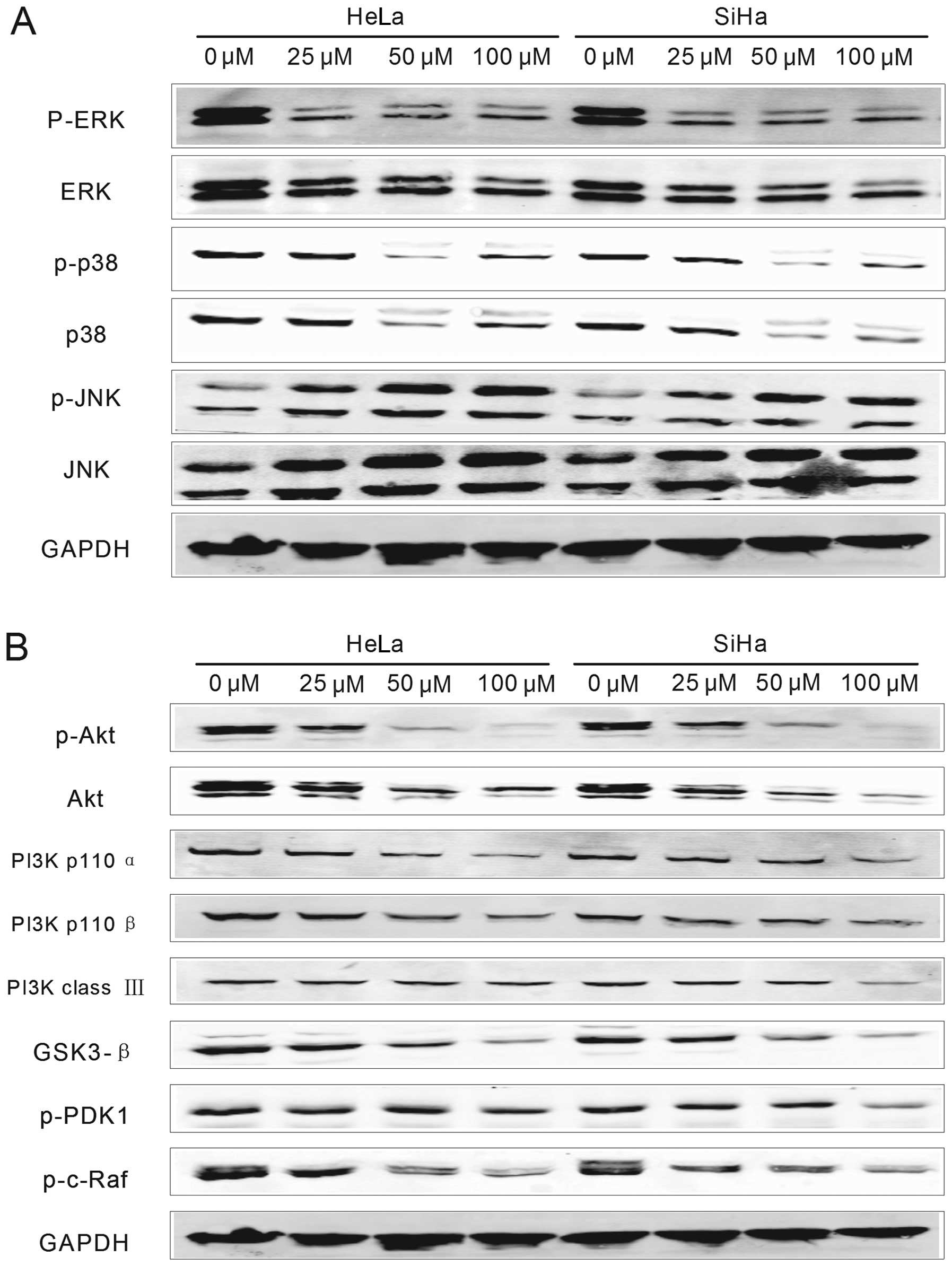|
1
|
Newall AT, Beutels P, Wood JG, Edmunds WJ
and MacIntyre CR: Cost-effectiveness analyses of human
papillomavirus vaccination. Lancet Infect Dis. 7:289–296. 2007.
View Article : Google Scholar : PubMed/NCBI
|
|
2
|
Tanaka T, Bai T, Yukawa K and Umesaki N:
Optimal combination chemotherapy and chemoradiotherapy with
etoposide for advanced cervical squamous cancer cells in vitro.
Oncol Rep. 15:939–947. 2006.PubMed/NCBI
|
|
3
|
Sarkar FH, Li Y, Wang Z and Kong D:
Cellular signaling perturbation by natural products. Cell Signal.
21:1541–1547. 2009. View Article : Google Scholar : PubMed/NCBI
|
|
4
|
Brew CT, Aronchik I, Hsu JC, et al:
Indole-3-carbinol activates the ATM signaling pathway independent
of DNA damage to stabilize p53 and induce G1 arrest of human
mammary epithelial cells. Int J Cancer. 118:857–868. 2006.
View Article : Google Scholar : PubMed/NCBI
|
|
5
|
Chinni SR, Li Y, Upadhyay S, Koppolu PK
and Sarkar FH: Indole-3-carbinol (I3C) induced cell growth
inhibition, G1 cell cycle arrest and apoptosis in prostate cancer
cells. Oncogene. 20:2927–2936. 2001. View Article : Google Scholar : PubMed/NCBI
|
|
6
|
Rahman KM, Aranha O, Glazyrin A, Chinni SR
and Sarkar FH: Translocation of Bax to mitochondria induces
apoptotic cell death in indole-3-carbinol (I3C) treated breast
cancer cells. Oncogene. 19:5764–5771. 2000. View Article : Google Scholar : PubMed/NCBI
|
|
7
|
Cover CM, Hsieh SJ, Tran SH, et al:
Indole-3-carbinol inhibits the expression of cyclin-dependent
kinase-6 and induces a G1 cell cycle arrest of human breast cancer
cells independent of estrogen receptor signaling. J Biol Chem.
273:3838–3847. 1998. View Article : Google Scholar
|
|
8
|
Fan S, Wang J, Yuan R, et al: BRCA1
inhibition of estrogen receptor signaling in transfected cells.
Science. 284:1354–1356. 1999. View Article : Google Scholar : PubMed/NCBI
|
|
9
|
Meng Q, Qi M, Chen DZ, et al: Suppression
of breast cancer invasion and migration by indole-3-carbinol:
associated with up-regulation of BRCA1 and E-cadherin/catenin
complexes. J Mol Med. 78:155–165. 2000. View Article : Google Scholar : PubMed/NCBI
|
|
10
|
Chang X, Tou JC, Hong C, et al:
3,3′-Diindolylmethane inhibits angiogenesis and the growth of
transplantable human breast carcinoma in athymic mice.
Carcinogenesis. 26:771–778. 2005.
|
|
11
|
Safe S, Papineni S and Chintharlapalli S:
Cancer chemotherapy with indole-3-carbinol, bis(3′-indolyl)methane
and synthetic analogs. Cancer Lett. 269:326–338. 2008.
|
|
12
|
Khwaja FS, Wynne S, Posey I and Djakiew D:
3,3′-diindolylmethane induction of p75NTR-dependent cell death via
the p38 mitogen-activated protein kinase pathway in prostate cancer
cells. Cancer Prev Res. 2:566–571. 2009.
|
|
13
|
Chinnakannu K, Chen D, Li Y, et al: Cell
cycle-dependent effects of 3,3′-diindolylmethane on proliferation
and apoptosis of prostate cancer cells. J Cell Physiol. 219:94–99.
2009.
|
|
14
|
Ge C, Xu J and Jiao Y: New derivatives
I3C-6 of indole-3-carbinol in cervical cancer HeLa cells. Suzhou
University J Med Sci. 29:838–834. 2009.
|
|
15
|
Chang YC, Riby J, Chang GH, Peng BC,
Firestone G and Bjeldanes LF: Cytostatic and antiestrogenic effects
of 2-(indol-3-ylmethyl)-3,3′-diindolylmethane, a major in vivo
product of dietary indole-3-carbinol. Biochem Pharmacol.
58:825–834. 1999.PubMed/NCBI
|
|
16
|
Zhou Y, Feng Y and Zhang X: Study on the
effect of artesunate combined with irradiation on DNA damage of
HeLa and SiHa cells of human cervical cancer. J Radiat Res Radiat
Process. 29:33–36. 2011.
|
|
17
|
Wang H, Zhang Y and Jiang K: Enhancement
of photodynamic therapy sensitivity by cisplatin in human cervical
carcinoma cell lines. J Xian Jiaotong University (Med Sci ).
31:625–630. 2010.
|
|
18
|
Han B, Toyomasu T and Shinozawa T:
Induction of apoptosis in cultured cells by extracts from shiitake
(Lentinula edodes) mycelial culture broth. Mycoscience. 41:623–631.
2000. View Article : Google Scholar
|
|
19
|
Fecher LA, Amaravadi RK and Flaherty KT:
The MAPK pathway in melanoma. Curr Opin Oncol. 20:183–189. 2008.
View Article : Google Scholar
|
|
20
|
Seger R and Krebs EG: The MAPK signaling
cascade. FASEB J. 9:726–735. 1995.PubMed/NCBI
|
|
21
|
Cobb MH: MAP kinase pathways. Prog Biophys
Mol Biol. 71:479–500. 1999. View Article : Google Scholar
|
|
22
|
Meira DD, de Almeida VH, Mororo JS, et al:
Combination of cetuximab with chemoradiation, trastuzumab or MAPK
inhibitors: mechanisms of sensitisation of cervical cancer cells.
Br J Cancer. 101:782–791. 2009. View Article : Google Scholar : PubMed/NCBI
|
|
23
|
Inamdar GS, Madhunapantula SV and
Robertson GP: Targeting the MAPK pathway in melanoma: why some
approaches succeed and other fail. Biochem Pharmacol. 80:624–637.
2010. View Article : Google Scholar : PubMed/NCBI
|
|
24
|
Lopez-Bergami P, Huang C, Goydos JS, et
al: Rewired ERK-JNK signaling pathways in melanoma. Cancer Cell.
11:447–460. 2007. View Article : Google Scholar : PubMed/NCBI
|
|
25
|
Mirmohammadsadegh A, Mota R, Gustrau A, et
al: ERK1/2 is highly phosphorylated in melanoma metastases and
protects melanoma cells from cisplatin-mediated apoptosis. J Invest
Dermatol. 127:2207–2215. 2007. View Article : Google Scholar : PubMed/NCBI
|
|
26
|
Flaherty KT: Sorafenib: delivering a
targeted drug to the right targets. Expert Rev Anticancer Ther.
7:617–626. 2007. View Article : Google Scholar : PubMed/NCBI
|
|
27
|
Sharma A, Tran MA, Liang S, et al:
Targeting mitogen-activated protein kinase/extracellular
signal-regulated kinase kinase in the mutant (V600E) B-Raf
signaling cascade effectively inhibits melanoma lung metastases.
Cancer Res. 66:8200–8209. 2006. View Article : Google Scholar
|
|
28
|
Greenberg AK, Basu S, Hu J, et al:
Selective p38 activation in human non-small cell lung cancer. Am J
Respir Cell Mol Biol. 26:558–564. 2002. View Article : Google Scholar : PubMed/NCBI
|
|
29
|
Kim MS, Lee EJ, Kim HR and Moon A: p38
kinase is a key signaling molecule for H-Ras-induced cell motility
and invasive phenotype in human breast epithelial cells. Cancer
Res. 63:5454–5461. 2003.PubMed/NCBI
|
|
30
|
Sossey-Alaoui K, Ranalli TA, Li X, Bakin
AV and Cowell JK: WAVE3 promotes cell motility and invasion through
the regulation of MMP-1, MMP-3, and MMP-9 expression. Exp Cell Res.
308:135–145. 2005. View Article : Google Scholar : PubMed/NCBI
|
|
31
|
Huang X, Chen S, Xu L, et al: Genistein
inhibits p38 map kinase activation, matrix metalloproteinase type
2, and cell invasion in human prostate epithelial cells. Cancer
Res. 65:3470–3478. 2005.PubMed/NCBI
|
|
32
|
Zwang Y and Yarden Y: p38 MAP kinase
mediates stress-induced internalization of EGFR: implications for
cancer chemotherapy. EMBO J. 25:4195–4206. 2006. View Article : Google Scholar
|
|
33
|
Lin A: A five-year itch in TNF-alpha
cytotoxicity: the time factor determines JNK action. Dev Cell.
10:277–278. 2006.PubMed/NCBI
|
|
34
|
Bowen C, Birrer M and Gelmann EP:
Retinoblastoma protein-mediated apoptosis after gamma-irradiation.
J Biol Chem. 277:44969–44979. 2002. View Article : Google Scholar : PubMed/NCBI
|
|
35
|
Li T, Dai W and Lu L: Ultraviolet-induced
junD activation and apoptosis in myeloblastic leukemia ML-1 cells.
J Biol Chem. 277:32668–32676. 2002. View Article : Google Scholar : PubMed/NCBI
|
|
36
|
Ouwens DM, Gomes de Mesquita DS, Dekker J
and Maassen JA: Hyperosmotic stress activates the insulin receptor
in CHO cells. Biochim Biophys Acta. 1540:97–106. 2001. View Article : Google Scholar : PubMed/NCBI
|
|
37
|
Stadheim TA and Kucera GL: c-Jun
N-terminal kinase/stress-activated protein kinase (JNK/SAPK) is
required for mitoxantrone- and anisomycin-induced apoptosis in
HL-60 cells. Leuk Res. 26:55–65. 2002. View Article : Google Scholar : PubMed/NCBI
|
|
38
|
Liao Y and Hung MC: Regulation of the
activity of p38 mitogen-activated protein kinase by Akt in cancer
and adenoviral protein E1A-mediated sensitization to apoptosis. Mol
Cell Biol. 23:6836–6848. 2003. View Article : Google Scholar : PubMed/NCBI
|
|
39
|
Garrett JT, Chakrabarty A and Arteaga CL:
Will PI3K pathway inhibitors be effective as single agents in
patients with cancer? Oncotarget. 2:1314–1321. 2011.PubMed/NCBI
|
|
40
|
Cantley LC: The phosphoinositide 3-kinase
pathway. Science. 296:1655–1657. 2002. View Article : Google Scholar : PubMed/NCBI
|
|
41
|
Blain SW and Massague J: Breast cancer
banishes p27 from nucleus. Nat Med. 8:1076–1078. 2002. View Article : Google Scholar : PubMed/NCBI
|
|
42
|
Inoki K, Li Y, Zhu T, Wu J and Guan KL:
TSC2 is phosphorylated and inhibited by Akt and suppresses mTOR
signalling. Nat Cell Biol. 4:648–657. 2002. View Article : Google Scholar : PubMed/NCBI
|
|
43
|
Nicholson KM and Anderson NG: The protein
kinase B/Akt signalling pathway in human malignancy. Cell Signal.
14:381–395. 2002. View Article : Google Scholar : PubMed/NCBI
|
|
44
|
Testa JR and Bellacosa A: AKT plays a
central role in tumorigenesis. Proc Natl Acad Sci USA.
98:10983–10985. 2001. View Article : Google Scholar : PubMed/NCBI
|
|
45
|
Zhou BP, Liao Y, Xia W, Spohn B, Lee MH
and Hung MC: Cytoplasmic localization of p21Cip1/WAF1 by
Akt-induced phosphorylation in HER-2/neu-overexpressing cells. Nat
Cell Biol. 3:245–252. 2001. View
Article : Google Scholar : PubMed/NCBI
|
|
46
|
Brugge J, Hung MC and Mills GB: A new
mutational AKTivation in the PI3K pathway. Cancer Cell. 12:104–107.
2007. View Article : Google Scholar : PubMed/NCBI
|
|
47
|
Ma JL, Lee SJ, Duong JK and Stern DF:
Activation of the checkpoint kinase Rad53 by the phosphatidyl
inositol kinase-like kinase Mec1. J Biol Chem. 281:3954–3963. 2006.
View Article : Google Scholar : PubMed/NCBI
|
|
48
|
Xu J, Gao M, Fan S, et al: Effect of Akt
inhibition on scatter factor-regulated gene expression in DU-145
human prostate cancer cells. Oncogene. 26:2925–2938. 2007.
View Article : Google Scholar : PubMed/NCBI
|
|
49
|
Junttila TT, Akita RW, Parsons K, et al:
Ligand-independent HER2/HER3/PI3K complex is disrupted by
trastuzumab and is effectively inhibited by the PI3K inhibitor
GDC-0941. Cancer Cell. 15:429–440. 2009. View Article : Google Scholar : PubMed/NCBI
|
|
50
|
Xie L, Chen X and Liu Q: Study of PI3K
p110α expression in cervical lesions. Pract Prev Med. 18:2011.
|
|
51
|
Shankar S and Srivastava RK: Involvement
of Bcl-2 family members, phosphatidylinositol 3′-kinase/AKT and
mitochondrial p53 in curcumin (diferulolylmethane)-induced
apoptosis in prostate cancer. Int J Oncol. 30:905–918. 2007.
|
|
52
|
Barnes NL, Warnberg F, Farnie G, et al:
Cyclooxygenase-2 inhibition: effects on tumour growth, cell cycling
and lymphangiogenesis in a xenograft model of breast cancer. Br J
Cancer. 96:575–582. 2007. View Article : Google Scholar : PubMed/NCBI
|
|
53
|
de Marsh RW, Rocha Lima CM, Levy DE,
Mitchell EP, Rowland KM Jr and Benson AB III: A phase II trial of
perifosine in locally advanced, unresectable, or metastatic
pancreatic adenocarcinoma. Am J Clin Oncol. 30:26–31. 2007.
|
|
54
|
Cirstea D, Hideshima T, Rodig S, et al:
Dual inhibition of akt/mammalian target of rapamycin pathway by
nanoparticle albumin-bound-rapamycin and perifosine induces
antitumor activity in multiple myeloma. Mol Cancer Ther. 9:963–975.
2010. View Article : Google Scholar
|
|
55
|
Floryk D and Thompson TC: Perifosine
induces differentiation and cell death in prostate cancer cells.
Cancer Lett. 266:216–226. 2008. View Article : Google Scholar : PubMed/NCBI
|
|
56
|
Zhang M, Fang X, Liu H, Wang S and Yang D:
Blockade of AKT activation in prostate cancer cells with a small
molecule inhibitor, 9-chloro-2-methylellipticinium acetate (CMEP).
Biochem Pharmacol. 73:15–24. 2007. View Article : Google Scholar : PubMed/NCBI
|


















